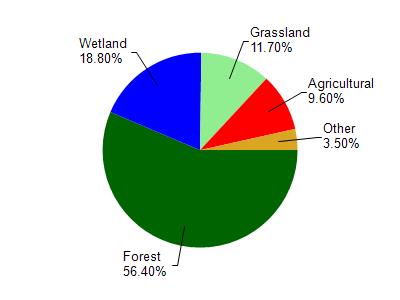Burnett, Polk
No
No
Yes
Fish and Aquatic Life
Historical Description
The eastern half of this watershed, which lies upstream of Long Trade Lake consists of
agricultural land uses which impact the class I11 trout fishery of the Trade River and also impact
downstream lake water quality. The eastern half of this watershed should be included in any
nonpoint source pollution control program (priority lakes project) aimed at improving water
quality in the Long Trade, Round and Big and Little Trade system.
Date 1992
Author Surface Water Inventory Of Wisconsin
Impaired Waters
Trade River was recently evaluated during the ten-year period of 2009 through 2018 for results that were reported to the USEPA for the 2020 Clean Water Act condition report. The waterbody is considered impaired, or in poor condition for designated uses which include the quality of fish and aquatic life, recreational use, and public health and welfare (fish consumption and related). Pollutants or problems encountered during sampling (impairments) are determined based on water quality standards outlined in Wisconsin 2020 Consolidated Assessment and Listing Methodology (WisCALM). Assessment results show water conditions that are potentially harmful for Aquatic Life use due to values for total phosphorus that fall into the range expected for an aquatic community in poor health, therefore this water is listed as impaired.
Trade River [4 segments (mile 0-32.24)]: The most recent assessments of this portion of Trade River do not show impairment.
Trade River [3 segments (mile 33.15-44.19)]: Assessment results during the 2020 listing cycle show total phosphorus levels too high for healthy aquatic communities like plants, fish, and bugs, according to 2020 WisCALM standards. Based on the most updated information, this water was proposed for the impaired waters list in 2020.
Trade River [2 segments (mile 44.19-50.76)]: There is not enough information about this portion of Trade River to assess condition.
Date 2019
Author Ashley Beranek
Condition
Wisconsin has over 84,000 miles of streams, 15,000 lakes and milllions of acres of wetlands. Assessing the condition of this vast amount of water is challenging. The state's water monitoring program uses a media-based, cross-program approach to analyze water condition. An updated monitoring strategy (2015-2020) is now available. Compliance with Clean Water Act fishable, swimmable standards are located in the Executive Summary of Water Condition in 2018. See also the 'monitoring and projects' tab.
Reports
Management Goals
Wisconsin's Water Quality Standards provide qualitative and quantitative goals for waters that are protective of Fishable, Swimmable conditions [Learn more]. Waters that do not meet water quality standards are considered impaired and restoration actions are planned and carried out until the water is once again fishable and swimmable
Management goals can include creation or implementation of a Total Maximum Daily Load analysis, a Nine Key Element Plan, or other restoration work, education and outreach and more. If specific recommendations exist for this water, they will be displayed below online.
Monitoring
Monitoring the condition of a river, stream, or lake includes gathering physical, chemical, biological, and habitat data. Comprehensive studies often gather all these parameters in great detail, while lighter assessment events will involve sampling physical, chemical and biological data such as macroinvertebrates. Aquatic macroinvertebrates and fish communities integrate watershed or catchment condition, providing great insight into overall ecosystem health. Chemical and habitat parameters tell researchers more about human induced problems including contaminated runoff, point source dischargers, or habitat issues that foster or limit the potential of aquatic communities to thrive in a given area. Wisconsin's Water Monitoring Strategy was recenty updated.
Grants and Management Projects
Monitoring Projects
| WBIC | Official Waterbody Name | Station ID | Station Name | Earliest Fieldwork Date | Latest Fieldwork Date | View Station | View Data |
|---|
| 2636000 | Trade River | 10037793 | Trade River 370m DS of CTH Z | 6/29/2012 | 1/1/2015 | Map | Data |
| 2636000 | Trade River | 10016499 | Trade River downstream of CTH Z N of 300th Ave | 11/8/2002 | 7/13/2020 | Map | Data |
| 2636000 | Trade River | 10051044 | Long Trade Lake - Outlet | 5/29/2018 | 5/30/2018 | Map | Data |
|

Watershed Characteristics
Trade River is located in the Trade River watershed which is 194.93 mi². Land use in the watershed is primarily forest (56.40%), wetland (18.80%) and a mix of grassland (11.70%) and other uses (13.10%). This watershed has 166.68 stream miles, 2,902.48 lake acres and 21,757.05 wetland acres.
Nonpoint Source Characteristics
This watershed is ranked Medium for runoff impacts on streams, Not Ranked for runoff impacts on lakes and Low for runoff impacts on groundwater and therefore has an overall rank of Low. This value can be used in ranking the watershed or individual waterbodies for grant funding under state and county programs.However, all waters are affected by diffuse pollutant sources regardless of initial water quality. Applications for specific runoff projects under state or county grant programs may be pursued. For more information, go to surface water program grants.